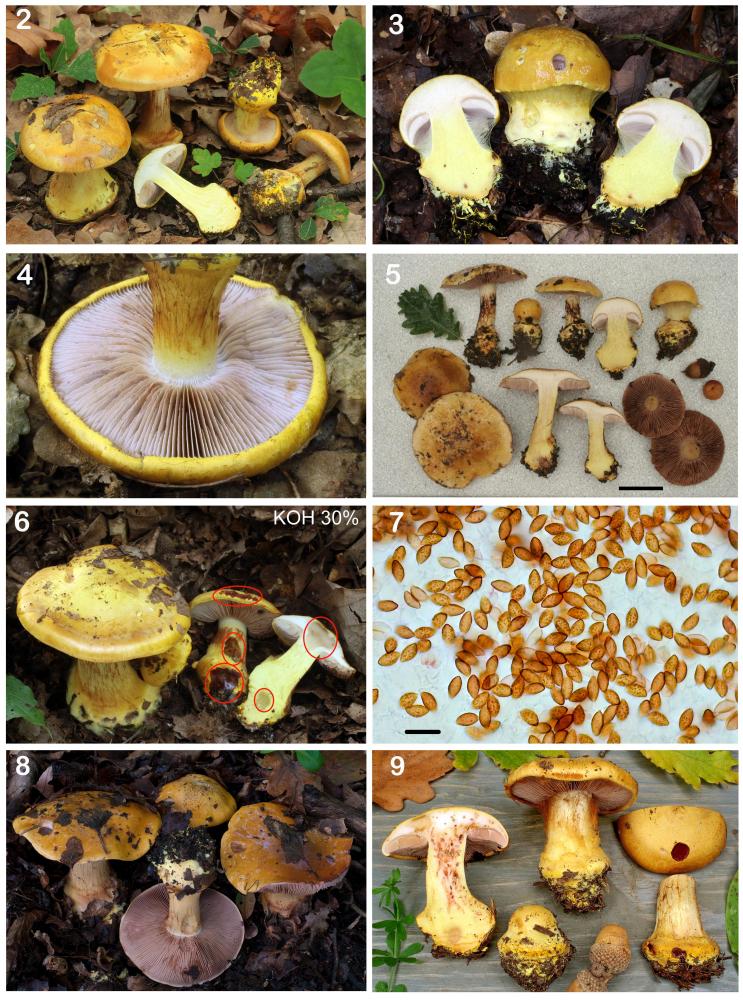You are here
Revision of Cortinarius prodigiosus from 2015, May 4 - 22:18
PILEUS 3–7(8) cm across, regular, hemispherical when young, then expanded, finally flattened to almost plane, slightly umbonate at centre, margin involute and incurved for a long time, surface smooth, sometimes slightly tomentose, slimy when wet, dry to slightly viscid in conditions of low humidity, sometimes partly covered with velar patches which tend to break into appressed olive brown to purplish-brown scales, finely innately fibrillose to subsquamulose towards the margin, cuticle easily peelable to 2/3, yellow, vivid yellow (2A6-8, 3A6-8) to orange yellow (4A-B7-8), later sometimes becoming dark yellow (4C8), olive yellow to olive brown. LAMELLAE crowded, L=100–110, abruptly adnexed to emarginate, with coarsely serrulate edge, whitish when young, soon becoming greyish-lilac (16C2) to greyish violet (17C3), brownish to darker brown when old. STIPE 40–70×12–15 mm, cylindrical, with a marginate rounded to cone-shaped bulbous base, up to 30 mm in diameter, solid, covered with conspicuous rust-coloured longitudinal fibrils of the partial veil, whitish at apex, sulphur yellow, greenish-yellow to light yellow (1A5-8, 2A4-5) below, bulbipellis and mycelial strands deep yellow (4A8), becoming orange (5A8) when exposed to air. UNIVERSAL VEIL at bulb margin quite abundant, vivid yellow (2A8), becoming conspicuously orange (5A8) with age. FLESH greenish-yellow (1A6-8) to yellow (2A6-7) at a larger part of stipe and at bulb base, strikingly contrasting with whitish colour at upper third of stipe and at pileus, yellow at a narrow zone under pileus cuticle, becoming reddish-brown in insect cavities. Smell of stipe base and basal mycelium initially like black pepper or Asarum europaeum; otherwise inconspicuous, slightly of baked potatoes or a bit sweetish. Taste mild, pleasant, that of cap cuticle like potatoes. COLOUR CHANGE: stipe surface and context of the holotype specimens turned greyish-green to olivaceous during drying process. MACROCHEMICAL REACTIONS: KOH 30% deep red to brownish-red on pileus cuticle and on bulb, reddish-brown on stipe surface, negative on flesh. Guaiac, FeSO4 10 % and phenol negative in all parts of the basidiome. BASIDIA hyaline, four-spored, clavate, 30–38×8–10 μm. BASIDIOSPORES amygdaliform to subcitriform, sometimes with an indistinct papilla at apex, irregularly ornamented, coarsely verrucose, (8.7)9.1–9.5–9.9(10.5)×(5.2–)5.4–5.6–5.8(−6.1) μm, Q=1.65–1.70–1.75, brownish in NH4OH 5 % and in KOH 3 %. LAMELLAR EDGE fertile, with some indistinct clavate, thin-walled cells, CHEILOCYSTIDIA not observed. PILEIPELLIS an ixocutis, simplex, composed of periclinal to ascending interwoven cylindrical to subcapitate hyphae and hyphal fragments with clamps, sometimes with branching tips, 2–5 μm wide, with punctate encrustations. The upper gelatinous layer appears to be greenish under the light microscope. HABITAT AND KNOWN DISTRIBUTION – Gregarious in thermophilous broad-leaved semi-natural forests (Quercus cerris, Q. petraea, Q. pubescens, Cornus mas, Sorbus torminalis, etc.) in leaf litter on calcareous bedrock (limestone, claystone, marlstone, loess); so far known from the Czech Republic (six sites) and Hungary (one site).

| Megye | Feltöltött rekordok száma |
|---|---|
| Bács-Kiskun | 0 |
| Baranya | 0 |
| Békés | 0 |
| Borsod-Abaúj-Zemplén | 0 |
| Budapest | 2 |
| Csongrád | 0 |
| Fejér | 0 |
| Győr-Moson-Sopron | 0 |
| Hajdú-Bihar | 0 |
| Heves | 0 |
| Jász-Nagykun-Szolnok | 0 |
| Komárom-Esztergom | 0 |
| Nógrád | 0 |
| Pest | 0 |
| Somogy | 0 |
| Szabolcs-Szatmár-Bereg | 0 |
| Tolna | 0 |
| Vas | 0 |
| Veszprém | 0 |
| Zala | 0 |
